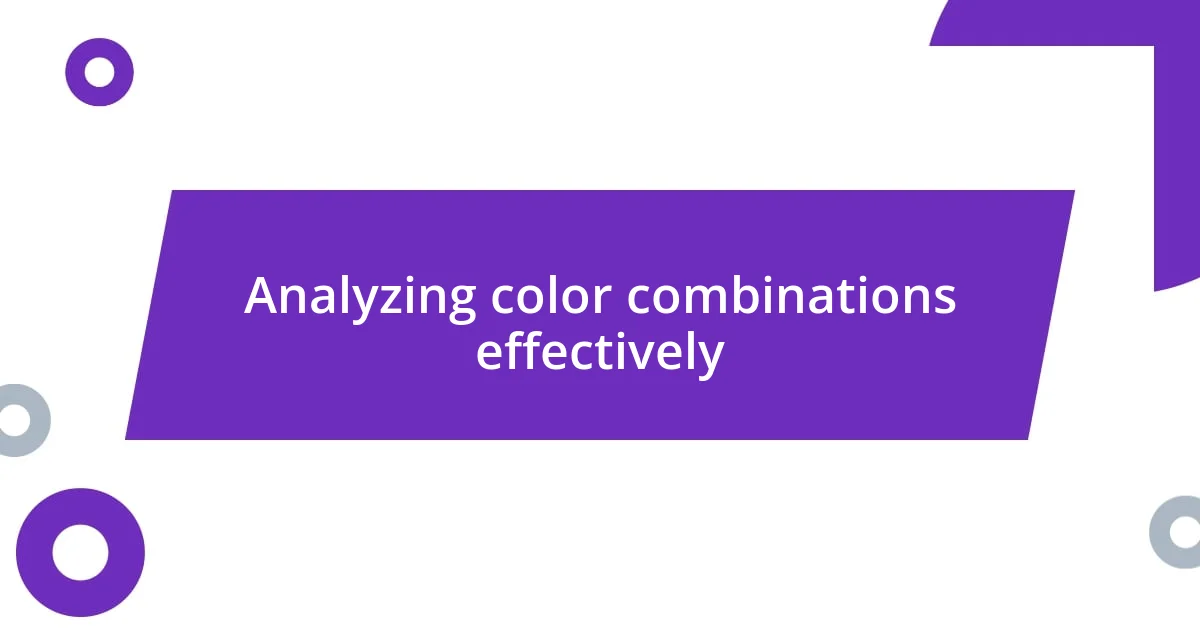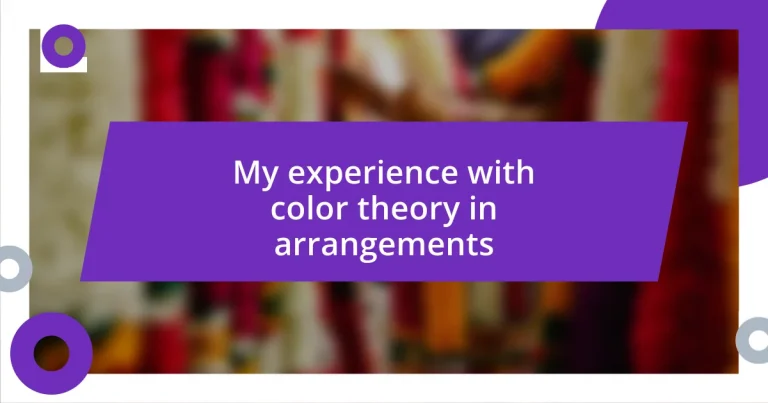Key takeaways:
- Understanding color theory fundamentals, including complementary and analogous colors, enhances emotional responses and creates impactful arrangements.
- Color choice significantly influences atmosphere; warm colors evoke energy, while cool colors promote calmness and relaxation.
- Experimentation with color contrasts and layering strengthens design complexity and visual interest, transforming ordinary arrangements into extraordinary experiences.

Understanding color theory principles
Color theory is the backbone of any effective arrangement, and I’ve found that understanding its principles can transform the way you perceive and use colors. For instance, when I first started experimenting with complementary colors—opposite hues on the color wheel—I was blown away by how they created a vibrant energy. It’s like a conversation between colors, one that sparks excitement and draws in the viewer’s eye.
As I explored the concept of analogous colors, which sit next to each other on the wheel, I realized how they can evoke a sense of harmony. I remember designing a floral arrangement using shades of pink, red, and orange. There was something deeply satisfying about seeing those colors dance together, creating a warm, inviting mood. It made me wonder—how often do we overlook the subtle beauty of color relationships in our everyday surroundings?
While color temperature plays a significant role in the mood of an arrangement, I’ve learned that it’s not just about what looks good. The emotions tied to certain colors can resonate with us on a personal level. When I chose calming blues and greens for a serene space, I felt an immediate sense of peace wash over me. Have you ever noticed how colors can shift your emotional state or even rekindle a memory? It’s a reminder of the profound power that color theory holds in our lives.

Importance of color in arrangements
Understanding the importance of color in arrangements goes beyond mere aesthetics; it shapes our emotional responses and perceptions. I vividly recall a project where I used bright yellows and soft blues. The result was an uplifting atmosphere that instantly made everyone feel more positive. Just imagine walking into a room filled with that kind of energy—doesn’t it feel inviting?
The psychological impact of colors in arrangements also plays a vital role. I once decorated a small reading nook with deep greens and earthy browns, specifically choosing colors that instilled a sense of grounding. Every time I entered that space, I felt centered and ready to dive into a good book. Isn’t it fascinating how intentionally selected colors can create such profound changes in our emotional landscape?
Furthermore, color contrasts—like incorporating dark hues with light ones—can add depth and interest to an arrangement. I remember designing a holiday centerpiece with rich burgundy and metallic gold accents. This combination created not only visual interest but also evoked a warm feeling of celebration—a contrast that sparked joy in everyone who gathered around the table. This depth, I’ve learned, draws viewers in, encouraging them to explore the arrangement further.
| Color Role | Emotional Impact |
|---|---|
| Warm Colors | Invoke energy and excitement |
| Cool Colors | Create calm and relaxation |
| Contrasting Colors | Generate interest and depth |

Analyzing color combinations effectively
When diving into the world of color combinations, I believe the key lies in experimentation. Recently, I played with a combination of teal and coral, and the transformation was remarkable. It’s as if those colors were made to complement each other, giving off a vibrant, cheerful vibe that reminded me of a sunny tropical beach. In doing so, I reflected on how certain pairings can ignite feelings of joy and excitement that resonate deeply within us.
To analyze colors effectively, consider these aspects:
- Contrast Levels: Look for differing levels of brightness and shade. For example, pairing a bright yellow with a muted navy creates striking visual tension.
- Cultural Associations: Colors evoke different feelings based on culture. I’ve noticed how reds can symbolize luck in some cultures, while they may signify caution in others.
- Personal Connection: Reflect on your own experiences with colors. For me, deep purples evoke nostalgia from my grandmother’s garden, influencing my choices in arrangements.
- Purpose and Mood: Think about the intended atmosphere. I wanted my living room to feel energizing, so I chose vibrant oranges paired with fresh greens, which made all the difference in mood.
- Flow and Balance: Ensure that the colors flow well together, creating a sense of balance. I learned this when using earth tones in an arrangement; too much of one color can feel overwhelming, while a balanced palette invites warmth and comfort.
Each of these points offers a guide that has enriched my understanding and approach to analyzing color combinations. It’s about creating that connection and feeling through color, something that transforms an arrangement into an experience.

practical color palettes for arrangements
Creating practical color palettes for arrangements is truly an art. One time, while designing a floral display for a friend’s wedding, I opted for a palette of soft pastels—think blush pinks, muted lavenders, and gentle creams. The result was a stunning harmony that felt romantic yet refreshing, inviting guests to linger and soak in the joy of the celebration. Wouldn’t you agree that the right color palette can completely set the mood for an event?
In another instance, I decided to experiment with bold, contrasting colors for a community art project. I used vibrant oranges combined with deep indigos. The striking visual play created a lot of buzz and engagement among attendees. It made me realize how daring color choices can ignite conversations and stimulate creativity. Isn’t it wonderful how some combinations can inspire unexpected joy?
Lastly, I’ve found that understanding the context of your arrangement matters greatly when selecting colors. For a cozy autumn gathering, I loved integrating warm terracotta shades with rich olive greens. This combination not only reflected the season but also created a snug atmosphere, encouraging everyone to relax and connect. What colors resonate with your own experiences in creating inviting spaces?

Experimenting with color contrasts
Experimenting with color contrasts has been one of the most enlightening aspects of my creative journey. I distinctly remember a project where I paired a vibrant magenta with a deep emerald green. This combination created an energy that was both refreshing and harmonious, evoking a sense of natural richness. Have you ever felt how a certain color can just “pop” when placed next to its counterpart? It’s like discovering a hidden treasure waiting to be unveiled.
In another instance, I dabbled with complementary colors, specifically orange and blue. While initially hesitant, once I arranged a bouquet incorporating these hues, the result was nothing short of spectacular. The dynamic interplay drawn from their contrasting energies sparked a lively atmosphere. It made me ponder: how drastically can a single color contrast alter the perception of an arrangement? Seeing that transformation first-hand taught me that playing with contrast can elevate ordinary designs into extraordinary statements.
I also experimented with monochromatic contrasts, using different shades of yellow to build depth. This approach allowed me to explore texture, adding a richness that wouldn’t have been possible with more diverse colors. I think this technique often gets overlooked, but my experience showed me that even subtle differences can create a striking visual narrative. Have you considered how multiple tones of a single color can impact the energy of your space? It’s a fantastic way to add complexity while maintaining cohesion.

Case studies in color application
While reflecting on my experiences with color application, I recall a stunning garden party where I utilized earthy tones, such as terracotta and sage green. The way these colors blended with the natural surroundings was mesmerizing, creating an inviting atmosphere that felt like an extension of the landscape itself. Have you ever noticed how certain palettes can make a space feel more connected to nature? I truly believe that the right colors can effortlessly bridge the indoor and outdoor experiences.
In another adventure, I created a winter-themed display utilizing cool blues and silvers, which was inspired by an icy landscape. The effect was magical, almost ethereal, as guests walked into a space that felt both tranquil and invigorating. It made me realize that seasonal contexts are ripe for exploration in color choices—what emotions do specific colors evoke for you during different seasons? I still remember the delighted expressions on my friends’ faces, which reflected how powerful the right colors can be in influencing mood.
Thinking back to a local festival, I experimented with a bold fusion of bright yellows and rich purples. It was a decision driven by the desire to reflect joy and excitement. The combination drew everyone’s attention, sparking conversations and laughter among attendees. Isn’t it fascinating how certain color pairings can energize a crowd? That experience solidified my understanding of color as a tool for connection; it’s about so much more than aesthetics—it’s about the emotions and memories colors can evoke in a shared space.

Tips for successful color integration
When it comes to successful color integration, I’ve found that starting with a clear focal color helps immensely. For instance, I often select a dominant shade that resonates with the theme of my arrangement, then build around it. It’s like anchoring your design; suddenly, all the other colors fall into place, forming a cohesive narrative. Have you ever noticed how a single, vibrant color can guide your eye throughout a space?
Another technique I’ve employed is layering colors in varying intensities. One time, I experimented with soft lavenders transitioning into deeper purples, which created a sense of sophistication and depth. I was amazed by how these slight variations added dimension without overwhelming the visuals. This layering allows colors to harmonize beautifully, and it makes me wonder: how can you use tonal shifts to enhance your arrangements?
Moreover, don’t underestimate the power of neutrals in the color mix. I remember an event where I complemented bold colors with subtle grays and whites. This not only provided breathing space but also allowed the brighter hues to shine even more. It’s a balancing act—how can you integrate calm tones to elevate your main colors? Striking this balance can transform your arrangement, making it not just vibrant, but also inviting.














